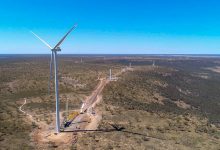Plans to build Australia’s biggest wind farm on grazing land near Hughenden, North Queensland, have been unveiled as part of a bid to provide low-cost energy for mining and industrial development in the state’s North West Minerals Province.
The $2 billion plan, revealed on Friday to the local Townsville paper, are being developed by a newly formed company called North Queensland Renewable Energy Zone (NQREZ), formed by a group of local engineers and grazier.
The company said the up to 1000MW (1GW) Mount James wind farm would be developed in stages and would rely on the development of the $1.5 billion CopperString transmission line planned for between Townsville and Mount Isa.
At 1GW it would be the country’s biggest wind farm to date, but in the end it will have some competition for that title – including from the 1.026 GW MacIntyre wind project in the same state that has already signed an off take agreement with CleanCo, the 1.2GW Star of the South wind project off the coast of Victoria, and competing proposals in NSW.
NQREZ executive director John Keir, who is a Townsville-based engineer, said site acquisition, feasibility and planning studies had been completed, with approvals and permitting likely within 12 months.
Financing of the massive project was expected to be completed by the September quarter of 2021, with construction of the first of the 200-odd wind turbines flagged for an early 2022 start.
The project, should it go ahead, would be a neighbour to Windlab’s troubled Kennedy Energy Park, which had designs on being the world’s first grid-connected facility to combine wind, solar and battery storage, potentially totalling a combined 1,200MW.
But completion of the KEP’s first-stage 40MW of wind, 20MW of solar and 2MW/4MWh Tesla battery has been put on hold due to a combination of a dispute between Windlab and its EPC partner, and ongoing negotiations with the Australian Energy Market Operator (AEMO) on a Generator Performance Standard – necessary before the project can be connected to the National Electricity Market.
Keir, said his company’s proposal was completely separate from Windlab’s and described it as a “major step in the right direction for the sustainable jobs and diversified infrastructure” that the Queensland government was seeking.
“A project like this not only provides sustainable benefit to the North but it increases the decarbonisation of Australia as a whole,” he told the Townsville Bulletin.
Flinders Shire Mayor Jane McNamara welcomed the proposal but stressed that it would need to be accompanied by a major upgrade to the region’s transmission infrastructure.
“I’m excited about it because it’s part of a whole plan for renewables,” Cr McNamara told the paper. “Obviously, it all hinges on CopperString going ahead.”
At this stage, the prospects for the CopperString project are looking good, having last month been given a $14.8 million boost by the state Labor government as part of its Covid-19 economic recovery plan.
Queensland premier Annastacia Palaszczuk said at the time that the funding aimed to help the transmission project to continue its important development activities and prepare for construction as soon as 2021.
Copperstring – or technically speaking, Copperstring 2.0, as this is the second time around for the plan after it was rejected by a previous state government – is one of 10 renewable “mega projects” listed by RenewEconomy as key contenders for critical, economy re-building post-Covid support.










